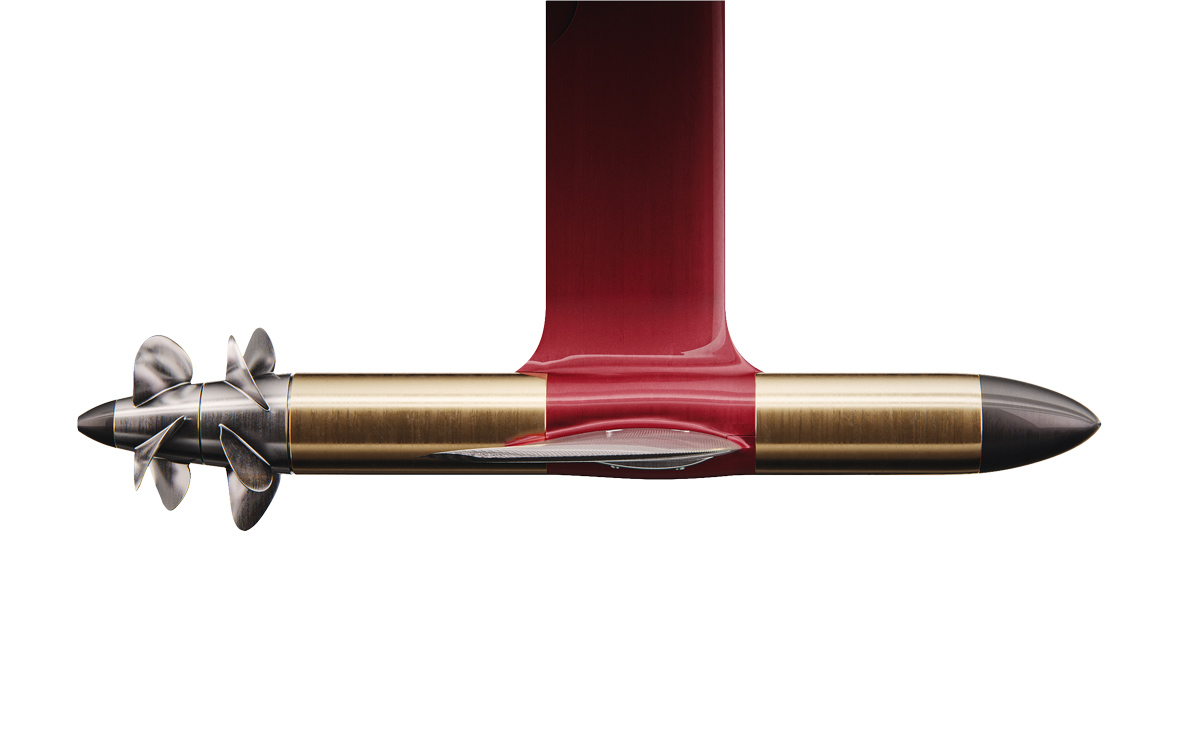Low maintenance, high efficiency, Candela has covered all the right bases with its new pod drive system, the Candela C-POD.
Not content with launching the world’s first production electric foiling boat, Candela has doubled down by launching the world’s first electric pod drive system.
Designed initially to power its new ‘mass market’ Candela C-8 leisure boat, the C-POD is a far neater, quieter, more efficient and versatile solution than the rather ungainly electric outboard created for its original Candela C-7.
It also has more wide reaching implications because of its suitability for powering larger craft. Candela has already confirmed it will be used in its 12-person P-12 taxi and 30-person P-30 ferry, and could be fitted to bigger leisure cruisers in future.
Much like Volvo’s IPS pod drive system, it could also be adapted for single, twin, triple or even quad applications, making electric power a viable propulsion source for considerably larger foiling boats.
Size matters
The secret of its success is a pair of very compact yet powerful electric motors mounted under the water in a slender torpedo-shaped tube. Each one directly drives its own small diameter propeller in opposite directions, creating a counter-rotating effect without the use of a gearbox.
It’s an exceptionally efficient solution that results in almost no frictional losses and brings with it a number of other benefits.
Foremost among these is unprecedented levels of refinement. With the motors now mounted well below the water rather than inside the hull or hung off the transom, noise and vibration is all but eliminated.
Article continues below…

Eegle 20m first look: World’s first electric trawler yacht takes on diesel rivals

Electric boats: A-Z of the 37 best all-electric models
Even the best electric motors still produce a noticeable whine at speed, especially when channeled through a gearbox.
They also produce a lot of heat which needs to be dissipated with the aid of a cooling system using energy-sapping electric pumps to channel water around the motor.
The C-POD’s motors are already immersed in a limitless pool of cooling water, which flows past it in direct relation to the speed of the boat and how hard the engines are working.

It’s nature’s own cooling system with no moving parts to go wrong, no filters to get blocked and no pumps to use up precious reserves of power.
To mount the unit underwater without creating excessive drag, Candela’s engineers knew they had to keep the diameter of the motors as small as possible.
The size of an electric motor is largely dictated by the torque it needs to develop rather than its maximum power (power is simply torque times rpm).

Each of the two compact electric motors spins its own propeller in a different direction to the other
So Candela decided to limit the torque but increase the rpm to deliver the requisite 50kW (67hp) while keeping the diameter of the two motors as small as possible.
Using two propellers rather than one also solves the issue of propeller tip speed. A single large propeller can only cope with a certain rpm before the tip speed of each blade starts to create a vacuum, causing the water around it to boil.
This generates noise and efficiency losses as well as causing possible damage to the propeller blades. Using two smaller diameter propellers means the blades can spin faster without the tip speed exceeding the critical 45m/s at which cavitation starts to arise.

The result is an efficient contra-rotating set-up
The final benefit is the sheer simplicity of the design and the reduction in maintenance costs and potential breakdowns.
With only a handful of moving parts and no gears, fuel systems, filters, pumps, oil changes or cooling mechanisms to worry about there is very little to go wrong and no servicing is required.
You don’t even need to winterise it; according to Candela the C-POD will run maintenance free for over 3,000 hours – more than the number of hours most owners put on their boats in a lifetime.
It’s also exceptionally small and light, taking up almost no room on the boat and weighing a mere 26kg, freeing up valuable space for extra accommodation or batteries.
Flying low
Being designed for foiling boats, the Candela C-POD is fitted with its own integral carbon-fibre foil to generate lift and can be raised and lowered vertically to reduce the boat’s draught in shallow waters.
On the new C-8 it’s mounted in the centre of the stern sunpad, with a small hole for the pod’s strut to rise through when lifted. The blade-shaped strut also swivels to vector the propellers’ thrust and help steer the boat.
Of course pod drives of any kind aren’t without issues of their own. Being permanently immersed in water they are more prone to fouling and corrosion issues.
And there’s always the risk you could hit a submerged or semi-submerged object. In foiling mode the Candela C-POD will only draw around the same as a shaftdrive boat and if it does strike an immovable object like a rock, it has been designed to shear off without compromising the hull’s integrity.
Candela also says the metal alloys used in the housing and propellers shouldn’t suffer any premature corrosion issues.
There’s no denying that the Candela C-POD is a very elegant design solution that, if it delivers on its promise, should herald a new generation of even quieter, cleaner, more efficient electric boats. We can’t wait to try it for ourselves.
Candela C-POD specification
Power: 50kW
Weight: 26kg
Propellers: Contra-rotating
Propeller efficiency: 80%
Service intervals: Maintenance-free for 3,000+ hours
First published in the December 2021 issue of MBY
If you enjoyed this…
Be first to all the latest boats, gadgets, cruising ideas, buying advice and readers’ adventures with a subscription to Motor Boat & Yachting. Available in both print and digital formats, our monthly magazine will be sent directly to your home or device at a substantial discount to the usual cover price. See our latest offers and save at least 30% off the cover price.









